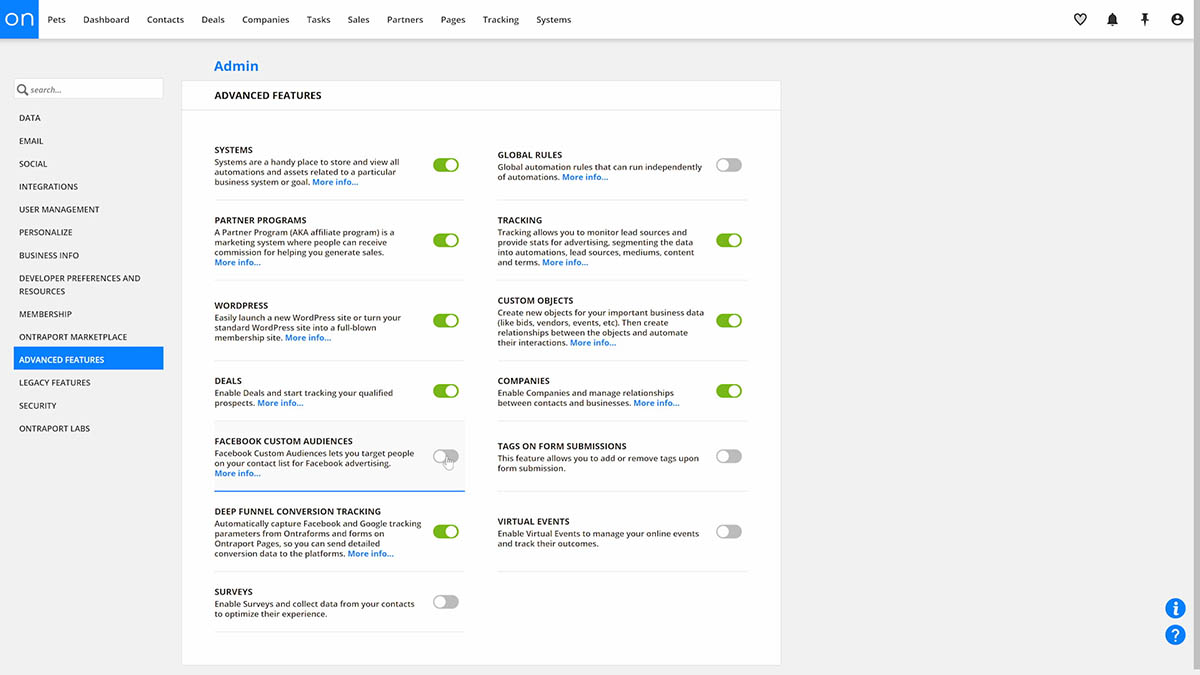With Ontraport’s CRM, you can view your contacts in a list, or you can choose to use Card View, which displays your contacts’ information like business cards and organizes them by stages within your business. Here’s an example:
You can tailor the cards to show only what you want to see at a glance, and you can dictate which stages you’ll divide the contacts into (these become the headers for each column).
This view is commonly used by live sales teams or any team that often interacts with clients in person or on the phone. It allows team members to manually drag and drop contacts to the appropriate category based on conversations or other intel, and it ignites appropriate manual or automated follow-up. Its visual cues also support team members in prioritizing which contacts to follow up with and gauging their progress toward their quotas and goals at any time.
From a management perspective, Card View provides a quick pulse on the quantity and type of contacts in each stage of your critical systems, enabling you to make data-driven decisions. You can more easily forecast results for budgeting and resource planning, spot weak points in your funnel to make improvements, and zero in on your team’s greatest opportunities to convert leads into customers or otherwise achieve your goals.
This article describes how to set up your own customized Card View in your account.
Check out the video about Card View to learn more.
If you’ve previously used List View and would like to start using Card View, check out the video about converting to Card View.
Steps
With Card View you have full control over what stages you want to show, what information shows up on each contact card, and how each user in your account views the funnel. Follow these steps to create your stages, cards and displays.
Getting Started With Card View
- Go to and select the group of contacts you want to apply Card View to. Card View can be used for groups of fewer than 25,000 contacts.
- In the top right, click to turn on Card View. The Card View settings dialog will open.
Creating Your Stages and Cards
The stages you organize your contacts into – in other words, the labels that show at the top of each column in Card View – can be based on any field in your contact records. The values in the dropdown for that field become the labels for each column. For example, if you have a Lead Status field with dropdown values such as New Lead, Considering Purchase, and Completed Purchase, those values will become your columns in Card View.
You can also choose to view full cards with more information or mini cards with just the essentials so that you can see more cards on one screen.
In the settings dialog:
- Under Column Settings, select the field you’d like to display as columns. If you don’t yet have the field that you’d like to use, click → + Create New Field to create a new dropdown field.
- Under Card Settings, choose Full Card or Mini Card to determine how much information you’d like to see at a glance, and select which fields you want to display on the card.
- Click .
Using Card View
Once your view is set up, you can interact with the cards using simple drag-and-drop functionality. Moving a contact’s card to a new column updates the related field in his or her contact record and can trigger any corresponding automation you’ve set up based on that field update.
You can also easily select certain contacts or groups of contacts and send them an email or SMS, add them to a specific automation map, or label them with a particular tag or field value using group actions just as you could in list view.
Use Cases
With Ontraport, you have the flexibility to customize your view to depict any system in your business. Here are a few possible use cases for Card View. For information on Deals and Companies, which is Card View specifically built for sales teams, view our Automate and Manage Your Sales Pipeline article.
New client onboarding
If you have an onboarding process to ensure new clients are properly welcomed and trained on your product, you could organize your Card View stages based on the steps involved, such as Welcome Call Scheduled, Welcome Call Completed, Training Video 1 Completed, 30-Day Check-in Email Sent, and so on. This way you can easily spot where clients get delayed and quickly tweak your outreach messaging approach to free up the flow.
New product launching
Say you’ve set up automation to create buzz around a new product. You can use Card View to gauge how effective your efforts are by dividing contacts into stages of the funnel. For example, you could designate stages for Signed Up for Pitch Webinar, Attended Pitch Webinar, Visited Order Page, and Purchased. This can be a useful way to estimate your conversion rates and revenues.
Client project management
If you’re a B2B service provider, you could use Card View for the stages of repetitive client projects, such as Proposal Sent, Proposal Accepted, Stage 1 Complete, Invoice Sent, Invoice Paid, and so on. This can be especially helpful with keeping track of the status of your interactions and ensuring you don’t miss an important approval or payment.
.png)
 and select the
and select the .png) to turn on Card View. The Card View settings dialog will open.
to turn on Card View. The Card View settings dialog will open..png)
.png) → + Create New Field to
→ + Create New Field to .png) .
.

